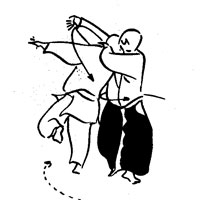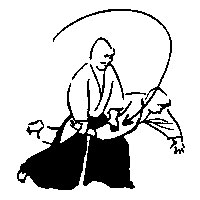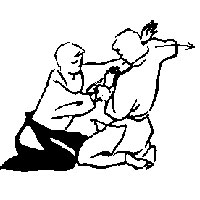Aikido activism lessons
The term "aikido activism" gets tossed around more than a white-belted uke in the progressive movement. As metaphors go, its a good one. Before you get on the mat yourself, here are a few basic lessons.
Yesterday's Yes Men antics re-awakened conversations around my office about doing more microphone stealing and "identity correction". We're no strangers to the method (at the time of this post, a search for "yesmen oil" on YouTube shows a past action as the second link) but my teeth still clench when I hear Aikido Activism misused. Hint: it doesn't mean "use their strength against them".
The phrase Aikido Activism, as far as I can tell, originates from an essay of the same name by Reed Burkhart, though the idea has been floating around for a while now (and even used by the bad guys). He describes it as:
a new form of activism combining corporate reform, financial markets strategies, entrepreneurship, et al.
In short, leveraging the power that corporations wield in today's society by turning bad companies into good ones. That's pretty close to the mission statement of my place of employment, but a greater understanding of aikido itself might illuminate exactly how such a thing is done.
I was part of a dojo for just over a year, reaching the rank of 5th kyu—which sounds impressive until you realize that a guy off the street starts at 6th kyu. Like the most effective activism, aikido is entirely non-violent. The goal is to neutralize an attack while having compassion for the attacker. It's perhaps better described via explanation of the first three techniques I was taught and what I would consider their Aikido Activism analogs.

Iriminage. Meaning "turning throw", iriminage is also called the 20 Year Technique (i.e., it takes two decades to learn it). The first step is to get out of the way of the attack. If you stand still, you get hit and violence wins. Get out of the way and your attacker may follow. If so, you have a chance to step behind. In order to press the attack, the attacker must turn to face you. You turn in place and quickly raise your center of gravity and your arm with it. The attacker, trying to avoid getting hit but also in motion, bends backward. If you step through the attacker completely loses balance and falls over.

Ikkyo. I think technically this means "first lesson" but, for reasons already mentioned, it's best to get iriminage in the oven before moving on. The first step is to get out of the way of the attack—honestly, this is the first step in every aikido technique but the first urge in so many people is to go on the offensive and make it a contest of strength. Don't do that. With ikkyo, you let the attack happen but not connect. Then you grab the attack as it zooms past, preferably by the wrist. Since the attack was trying to hit you, there's power behind it (this is probably where the "use their strength against them" myth comes from). As you turn, put your other hand on the attacker's shoulder and you create an axis around their hips that they will rotate on, in order to stay attached to their fist. Suddenly, you've got them pinned. It can surprise you the first time you get it right.

Kokyudosa. We would end all of our training sessions with kokyudosa. You sit on your knees, facing your partner. You lay your hands on your knees, palms up, and your partner grabs your wrists. You have to throw them from this position. Beginners twist and turn and writhe, teachers watching and probably trying not to laugh. Eventually you discover that if you settle into your own weight and project your hands beyond your partner—trying to grab a ball 100 yards behind them—the dynamic shifts instantly and they go flying. Like magic.
Doing these techniques at a protest, on riot cops, would land you in jail fast. Even though they're "non-violent", police officers like to be in charge and pinning them wounds egos if not bodies. Instead, consider them metaphorically.
Iriminage is about finding the moment where the cycle of destruction depends on you, and seizing the opportunity to end it. A boycott, for instance, is consumers realizing that corporations require people to buy their stuff in order to exist. For publicly traded companies, shareholder activism is a similar tactic. Once the corporation is listening, you can raise the expectations of social responsibility like you would your arm, to the point where they will either have to meet them or fall over backwards.
Ikkyo is about pitting the attacker's desire for destruction against their desire for self-preservation. Sending the two in different directions means they can't have both and they will almost always choose the latter. You can see this when activists raise the reputational risk around a project without explicitly targeting a corporation. Since the public is quick to damn corporate greed in the abstract but loath to criticize specific ones, this has the effect of giving corporations a choice of continuing an irresponsible behavior or keeping their name clean.
Kokyodosa is about projection. When we, as activists, are focused on the fight and not the future we wriggle and squirm and come up empty. When we formulate a vision for the world we want ten, twenty-five, or fifty years from now we can act with calm and confidence in the moment, which in turn gives us strength beyond our own expectations.
Of course, these are just simple examples and the Yes Men are black belts. They employ all sorts of advanced aikido techniques, like leading (gaining audiences' trust before springing the trap) and stealing balance (turning normally stolid executives flustered and defensive). Since I've recently started to get calls at my office for someone who is not me, inviting me to have dinner with President Bush and serve on Business Advisory Councils, I think I need to enroll at their dojo and finally make it to 4th kyu.
Ended up as as pretty long post. Credit to Oscar Ratti for the art from Aikido and the Dynamic Sphere, the best illustrations of aikido in motion I've ever seen.